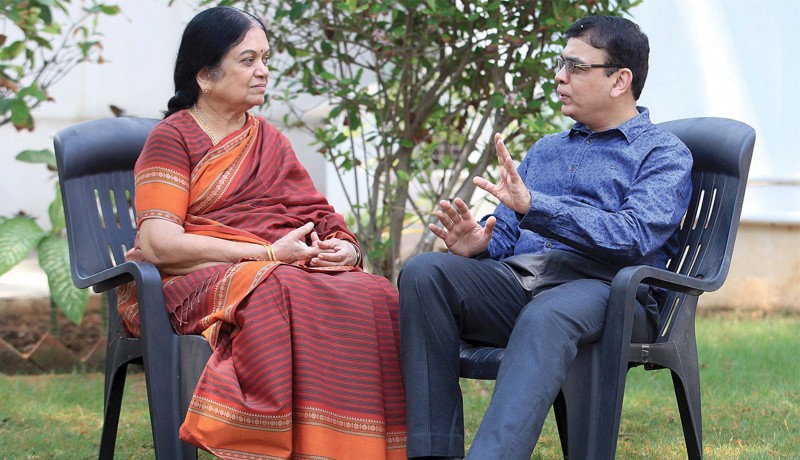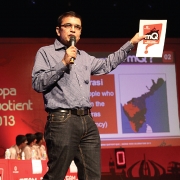
Etcetera

Three generations of quiz enthusiasts find themselves at the receiving end as Pratibha Jain asks them what drives them to lead some of the country’s most prestigious quiz contests.
Quick question: ‘Who is the first family of quizzing in India?’ No prizes for guessing the right answer, nor any penalties for drawing a blank, for participating in a quiz is its own reward, smiles 76 year-old Saranya Jayakumar, aka the Queen of Indian Quizzing.
Saranya is the first of three generations of quizzers in the Chennai-based Jayakumar family, unarguably a rarity. Her 54 year-old son Dr Navin Jayakumar, an ophthalmologist, is a noted quizmaster and host of the very popular Landmark Quiz, while her younger sons Niranjan and Srikanth are keen quizzers, and Navin’s son Ishwar is a quizzer and amateur quizmaster.
“My first memory of quizzing is of the family gathered around the radio on Sundays in the 1970s, to listen to Ameen Sayani conduct the Bournvita Quiz Contest. It was one of the first radio quiz shows of its kind and we never missed it!” recalls Dr Navin. “I was an average student in school and, invariably, it was the top rankers who were chosen to represent the school at quiz competitions,” he laughs. But Navin had one advantage: being an avid reader, his general knowledge was outstanding. So when the school once conducted a written quiz, he scored surprisingly well and discovered his latent interest.
He inherited this penchant from his mother Saranya, arguably the country’s first woman quizmaster. With a master’s in English literature from Presidency College, Chennai, Saranya was a quiz enthusiast even during her college days. Back in the 1960s, there were no quizzing boards and hardly any quizzing activities. “In fact, there weren’t many distractions, so reading became a passion,” remarks Saranya, author of 1000 Religion Quiz, a compilation of 1,000 questions about religion. In college, she participated in a couple of quiz competitions and took home the trophies. The competitions were modest but they awakened a passion that turned Saranya into a quizzing juggernaut.
But 16 years passed before that force was unleashed, for, in the meantime, she got married and the family moved to Kolkata. Then, in 1978, her nephew came to visit and spotted an advertisement for the North Star Quiz in the newspaper; he convinced his aunt to team up with him and participate. Although they did not win, it set Saranya firmly on the quizzing trail. Along with three others, she assembled a team known as ‘Motley Crew’, which became a force to reckon with in quizzing circles.
Saranya read voraciously, and from 1978 to ’85, became an avid quizzer. Why, her team even competed against quizzing champions like Neil O’Brien (father of Derek O’Brien) and came away with top honours in the North Star Quiz in 1980. They also won the All-India Round Table Quiz, and their winning spree continued in the years to come.
In the mid-80s, the Jayakumars moved to Chennai, a bit of a dampener because Kolkata was then the quizzing capital. Navin who was in Chennai studying for his MBBS at Madras Medical College was by then actively participating in inter-collegiate and regional quizzing. Saranya became a part of her son’s team, ‘Memory Bank’. Known as the ‘South Indian champions’, the team comprised Saranya, her sons Navin and Srikanth, and their friend Gautam Padmanabhan. Together, they took quizzing circles by storm, recalls Saranya, who still participates in quizzes conducted by the International Women’s Association.
Narrating a treasured memory, Saranya says she once got a call from the hugely popular quiz, Mastermind, where Siddhartha Basu was the quizmaster. Basu kept referring to her as the ‘housewife from Madras’, she remembers with a wry laugh. In time, Navin graduated to becoming a quizzing host. Suave and charismatic, he began hosting the Madras Book Fair Annual Quiz from 1983-85 and then the popular Landmark Quiz at the age of 26 in 1988. It grew to become the largest open team quiz in India. His favourite memory is of the Madras 350 Quiz held in 1989 as part of Chennai’s 350th birth anniversary celebrations. The quizzing rounds lasted four days and held the audience spellbound. It was his first experience as a professional quizmaster. In 2014, when Chennai celebrated its 375th birth anniversary, Navin was the quizmaster again. A gentleman from the audience came up to him and introduced himself, saying he had participated in the Madras 350 Quiz and now his son was participating in the Madras 375 Quiz; both times with Dr Navin as the host. “That was unforgettable. It was the same feeling that gripped me when I was telling a patient how I had operated on his mother on the same table!”
For Navin, quizzing is like a sport. Just as cricket has a bat and ball, chess has its pieces, quizzing is played with bits of information—some useful and some not so useful, but never uninteresting. And although winning is the ultimate goal, it’s also about the joy of working as a team. “Around 400 to 700 teams turn up every year for the Landmark Quiz. The ones that reach the finals are invariably the same teams every year. I enjoy the preliminary rounds where everyone gets to participate. I always wonder what makes them come year after year? I think it is the joy of participation, which is exactly how it should be,” muses Navin, who conducts six Landmark Quizzes across cities every year.
A good quizzer must obviously take a keen interest in current news and events, and general knowledge. But, Navin says, he or she must also have a fascination for strange things. He once asked: ‘What element of a movie experience was initially required in theatres everywhere because of the presence of physical film reels? Although digital projections caused this to disappear in cinemas across the world it still exists in India because of its great commercial value.’ The quizzers promptly came up with the answer: ‘The intermission!’
Saranya adds her wisdom. “Just as a magpie picks out shiny bits from a heap, a passionate quizzer tends to notice strange, unusual and extraordinaty bits of information in what he reads and sees.”
What makes for an exciting quiz? “One where the questions include clues to allow the participants to make an educated guess. The aim is to enhance knowledge,” explains Saranya, who authored a quiz column in Eve’s Touch magazine for 20 years. Navin adds, “The best quiz is when everything is answered after debate and discussion. Also, the quizmaster must be a sport and provide the right clues.”
Is quizzing a legacy Navin has inherited? “I think my mother’s passion has rubbed off on all of us,” he answers. My brothers are not as crazy about it as I am, but the last time my brother visited, I noticed him playing quiz games with his son on the Internet. My mother helps me even now with preparing questions. She does a lot of reading and suggests questions which I can incorporate in my next quiz. We are, after all, a team!”
Quizzing in India
- Quizzing in India in the 1960s was largely restricted to schools and colleges. Neil O’Brien is credited with popularising the ‘open teams’ format that opened up quizzing as far back as 1967 in Kolkata. Bournvita Quiz Contest, which aired on AIR for many years from 1972, and Siddhartha Basu’s Quiz Time telecast on Doordarshan from 1985, were landmarks that brought quizzing into people’s homes. Quiz groups like the Karnataka Quiz Association (started 1983) and The Quiz Foundation, Chennai (started 1987), along with quiz organisations in other cities, have since made quizzing a thriving pan-India movement.
- Quizzing on television is quite a different animal—it is more a game show with not much emphasis on general knowledge. However, live quiz contests like the Landmark Quiz have not shown any decline in enthusiasm and school quizzes in that format have really taken off with increasing participation from B and C cities in India.
Quiz time!
1. The British in India were fond of houses that were built in a traditional ‘Bengali style’—small, only one storey and detached, with a wide veranda. The name of these detached homes is now part of the English language and means ‘house in the Bengali style’. What were these houses called?
2. What ‘geographical’ term was first used to describe the location of the first atomic test explosion during the Manhattan Project and subsequently the first nuclear bombing of Japan?
3. In Latin if Julius Caesar’s famous quotation, “Veni, vedi, vici” means “I came, I saw, I conquered”, what is the Latin word for “I forbid” that can be used in the UN Security Council?
4. The plaque for this award was designed by Satyajit Ray. Prior to this, the plaque occasionally was made of marble, but this practice was discontinued because of the excessive weight. During the Indo-Pakistan war of 1965, the plaque was substituted by a national savings bond. Which award is it?
5. Why does Panjab University in Chandigarh, which was originally set up in 1882 in another city, have the anglicised spelling ‘Panjab’ instead of ‘Punjab’?
ANSWERS
1. Bungalow; 2. Ground Zero; 3. Veto; 4. Sahitya Akademi Award; 5. To differentiate it from Punjab University, Lahore, where it was originally founded
Photo: Chennai & Pix courtesy: Murugappa Group Featured in Harmony — Celebrate Age Magazine June 2016
you may also like to read
-
Cracking the longevity code
Small yet impactful choices can be game-changers, writes Srirekha Pillai At 102, there’s no stopping Chandigarh-based Man Kaur, the world’s….
-
Home, not alone
While a regulatory framework is vital for senior-care facilities, the need of the hour is to develop an ecosystem to….
-
Birthday Girl
Published in a special edition to honour Japanese master storyteller Haruki Murakami’s 70th birthday, Birthday Girl (Penguin; Rs 100; 42….
-
A huge treat for music lovers
Published as the revised and updated second edition, Incomparable Sachin Dev Burman (Blue Pencil; Rs. 599; 470 pages) the authoritative….








